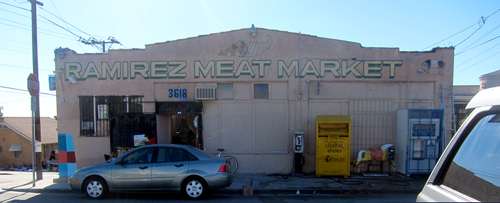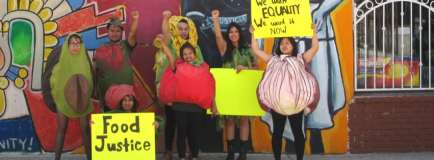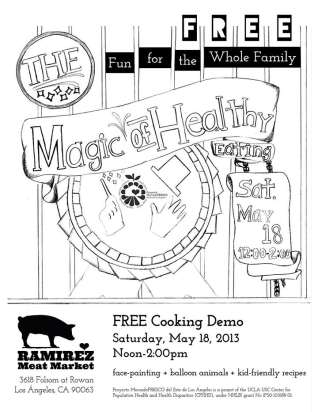Share On Social!
Atop a hill in East Los Angeles, Ramirez Meat Market has spent three decades as a neighborhood fixture. However, the market hasn’t been a beacon of health. Celia Ramirez, who has owned the store for the last 10 years, runs it by herself following her husband’s death in an automobile accident. Now, with some community help, Ramirez transformed her meat market from a typical junk-food-filled corner store into a place that where the community can find nutritious food options and embrace a healthier lifestyle.
EMERGENCE
Awareness: East L.A. is an urban community that is 96% Latino and has high rates of obesity-related chronic diseases. Small corner stores and meat markets are abundant in the community, but sell mostly junk food and few fresh fruits and vegetables, and/or poorly advertise the little healthy food they do have.
Ramirez Meat Market was one of these corner stores.
The market didn’t offer many fruits and vegetables. Neighborhood residents had to drive pretty far to get to a grocery store that sold healthy snacks like apples and grapes.
The market’s owner, Celia Ramirez, started to see her market as a contributor to the problem.
“It’s good to offer people fruits and vegetables because in these days there are lots of people with high blood pressure and diabetes,” Ramirez said. She saw the effects of chronic disease all over her neighborhood, in her customers, and especially in children. Something had to change.
Learn: As part of the UCLA-USC Center for Population Health and Health Disparities, a group of academics and community organizations were looking to partner with local corner stores to “make over” the stores into places that sold more fresh produce, engaged in healthy marketing, and were more visible in the community. They decided to call the project Proyecto MercadoFRESCO.

Source: Public Matters LLC
http://www.publicmattersgroup.com/wp-content/uploads/2012/10/RamirezExteriorFront-Before1.png
Before a store is approached to participate, Nathan Cheng of Public Matters, a community organization involved in the market makeovers, likes to nose around.
“I actually go out and do some observation and surveillance of the community I’m working in.…just to get a sense of how they interact with me as a stranger,” Cheng said.
He visited a couple of stores in the East L.A. area. He looks at store cleanliness, layout, and owner involvement (are they sweeping or watching TV?). These sorts of observations are important because revamping a corner store isn’t just a one-time thing, it takes a long-term commitment from the owners for it to be successful, Cheng said.
Frame Issue: Cheng determined that Celia Ramirez’s store was a good fit for the makeover.
Because it’s a meat market, Ramirez already keeps the store very clean because of many health inspections. She was already selling some vegetables for cooking like cilantro and jalapeño peppers, so she knew about produce purchasing. Ramirez is also very engaged in the community, having owned that store for 10 years and raised three children in that neighborhood. The location was a plus because of that area’s limited access to fresh fruits and vegetables.
DEVELOPMENT
Education: To get youths involved in the makeovers, Public Matters worked with two East L.A. high schools.
Students that choose to participate in elective classes learn about food access and healthy eating and nutrition, not only on a large scale but also as it relates to their own community in East L.A.
“I realized that it wasn’t fair that because I was born in East Los Angeles, because I was Latina, because my friends were low-income, I was high risk for cardiovascular disease, I had a shorter life expectancy,” said Lilybeth Hernandez, a student involved in the Ramirez store makeover. “It just didn’t add up.”
The students also learned about how creative advertising and social media can be used to promote healthy living in their community.
Public Matters head Mike Blockstein said it’s about training the youth to be change agents, “because ultimately they aren’t just responsible for the physical change in the community… but the behavior change.”

Source: Public Matters LLC
http://www.publicmattersgroup.com/cphhd/
Mobilization: Next, students honed advertising skills by working to promote the future makeover of Ramirez Meat Market. They created eye-catching flyers and held “wacky photo shoots” of themselves to encourage the community to eat healthier, Blockstein said. At one point, the students dressed in self-constructed fruit and vegetable costumes and went around the neighborhood with a mariachi band, advertising the grand “re-opening” of Ramirez. When the effort is home-grown, Blockstein says, the community is more likely to take notice.
Debate: In many small neighborhood corner stores, big food corporations influence where the storeowners place, advertise, and promote their products. Typically, these items are things like chips and soda. Cheng likes to ask store owners questions like, “Who do you really want to do business for… big food corporations?” Ramirez had to consider addressing this question in her store, because junk food advertising was taking up some valuable space in her store that could be used for healthier food or simply more space for customers to walk.
ENACTMENT
Activation: Students continued to promote the revamped meat market with flyers and skits around the community. It wasn’t just about advertising for the meat market; it was also about helping the community become more aware of their food choices.
“It’s normalizing the behavior of fruits and vegetables but in a humorous way,” Blockstein said.
“I participated in parades and veggie fashion shows and photo shoots…I wanted to start a conversation about the fact that food deserts do exist and that there is a problem in food access,” Hernandez said.
Frame policy: With funds UCLA received from the National Institute for Health, the group would be able to make physical improvements to the interior and exterior of the store, buy new produce cases, and pay for the initial produce offering.
After that, Ramirez would be responsible for continuing to purchase fruits and vegetables and upkeep of the new additions.

Source: Public Matters LLC http://www.publicmattersgroup.com/cphhd/
Change: In February 2013, Ramirez Meat Market had its grand “re-opening”, showcasing all the physical changes as well as the healthier produce offering. While the store was never closed for more than an hour or so during the renovations, a lot had changed. The interior and exterior of the store was painted, windows that were boarded up had the boards removed and replaced with glass, and the retail space was reconfigured to highlight the healthier food options—all to make the store more welcoming to customers. A produce case and additional shelves were installed and the compressor for the meat counter was replaced and upgraded. More fruits like grapes, strawberries, watermelons, papayas, and peaches were added to the shelves.
Ramirez also decided to remove some of the extra advertising on store shelves by big corporations, deciding that more space for customers to walk was better than advertising chips.
“There’s a whole part of that community that’s on top of the hill that now…has the option to go buy healthy fruits and vegetables within walking distance,” says Cheng.
IMPLEMENTATION
Implementation: To keep the community excited about the healthy changes at Ramirez Meat Market, the students developed a social media and marketing campaign. Students also have held and will continue to hold cooking demonstration to highlight some of the healthy meals a person could make with food from the store.
“Sometimes it gets a little hectic,” Ramirez said about the cooking demos. “It’s a lot of work, but it’s only one day.”
Equity: When Cheng works with store owners, he likes to emphasize that although produce may not be the biggest moneymaker in the store, having those healthier options does bring more customers in and drives up overall sales.
Ramirez has seen her business grow, both in sales and in customers. She says that people are so glad they can walk to her store for things like broccoli, instead of driving to the big supermarket.
Sustainability: Gross sales at Ramirez have increased about 50% to 60% since the re-opening. Before the change, Ramirez only bought fresh fruits and vegetables once a week; now she goes practically every day.
“Now people will ask if I can bring in new vegetables, like different kinds of squash” she said.
Ramirez is proud to offer more healthy options in her store, even if it means she has to make daily trips to the grocery.
“It’s a great thing because you do see a change,” she said. “I like to work hard, so it isn’t hard.”
Meanwhile, as this video shows, Hernandez went on to become a Community Liaison with Proyecto MercadoFRESCO, going into schools and teaching them about fruits and veggies and the importance of healthy food access. In fall 2013, she started school at New York University to pursue a degree in public health, inspired by her work with Public Matters and her desire to see health disparities erased in all communities.
Because of Ramirez, the students, and all the other partners in the process, this East L.A. community is able to make healthy living a little bit easier.
This success story was produced by Salud America! with support from the Robert Wood Johnson Foundation.
The stories are intended for educational and informative purposes. References to specific policymakers, individuals, schools, policies, or companies have been included solely to advance these purposes and do not constitute an endorsement, sponsorship, or recommendation. Stories are based on and told by real community members and are the opinions and views of the individuals whose stories are told. Organization and activities described were not supported by Salud America! or the Robert Wood Johnson Foundation and do not necessarily represent the views of Salud America! or the Robert Wood Johnson Foundation.
ABOUT THE PROGRAM
Salud America! The RWJF Research Network to Prevent Obesity Among Latino Children is a national program of the Robert Wood Johnson Foundation. The program aims to educate researchers, decision-makers, community leaders, and the public in contributing toward healthier Latino communities and seeking environmental and policy solutions to the epidemic of Latino childhood obesity. The network is directed by the Institute for Health Promotion Research at the University of Texas Health Science Center at San Antonio.
For more information, visit http://www.salud-america.org.
By The Numbers
1
Supermarket
for every Latino neighborhood, compared to 3 for every non-Latino neighborhood
This success story was produced by Salud America! with support from the Robert Wood Johnson Foundation.
The stories are intended for educational and informative purposes. References to specific policymakers, individuals, schools, policies, or companies have been included solely to advance these purposes and do not constitute an endorsement, sponsorship, or recommendation. Stories are based on and told by real community members and are the opinions and views of the individuals whose stories are told. Organization and activities described were not supported by Salud America! or the Robert Wood Johnson Foundation and do not necessarily represent the views of Salud America! or the Robert Wood Johnson Foundation.



